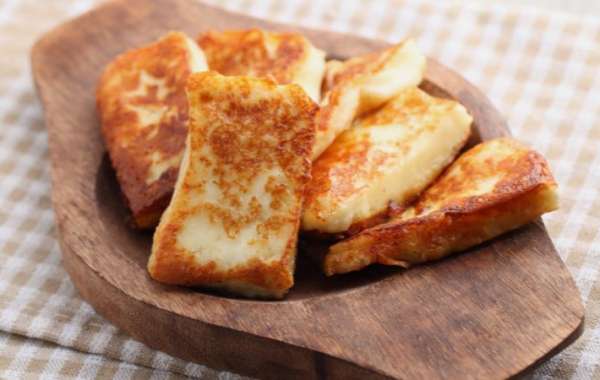Halloumi cheese is a type of semi-hard cheese that originated in Cyprus and is popular in the Middle East and Mediterranean regions. It has a distinctive squeaky texture and a salty flavor that makes it ideal for grilling and frying. Halloumi cheese is also a versatile ingredient that can be used in various dishes, from salads and sandwiches to pizzas and burgers. In this blog post, we will explore the history, characteristics, uses, benefits, and market trends of halloumi cheese, and why it is becoming more popular in Western cuisine. We will also share some tips and recipes on how to enjoy this cheese at home.
Halloumi in the Global Market
Halloumi cheese is not only a local and regional delicacy, but also a global one, as it has a high demand and a growing market in various countries. Here are some of the facts and figures about halloumi cheese in the global market:
- Export Trends and Market Demand: Halloumi cheese is one of the most exported products from Cyprus, as it accounts for about 15% of the total exports of the country. Halloumi cheese is mainly exported to the UK, which is the largest market for the cheese, followed by other European countries, such as Germany, Sweden, and France. Halloumi cheese is also exported to other regions, such as the Middle East, North America, and Australia, where it has a growing demand and popularity.
- Market Growth and Future Prospects: Halloumi cheese has a high potential for market growth and expansion, as it is expected to increase its production, export, and consumption in the coming years.The global halloumi cheese market size attained a value of more than USD 555.20 million in 2023. The market is further expected to grow in the forecast period of 2024-2032 at a CAGR of 10.5% to reach over USD 1,363.59 million by 2032.
Halloumi cheese is a versatile ingredient that can be enjoyed in various ways and dishes. It is also a healthy and sustainable food that has a positive impact on the environment and the local community. Halloumi cheese is also a global product that has a high demand and a growing market in various countries. Halloumi cheese is a cheese that has it all: taste, nutrition, sustainability, and marketability.
History and Origin
Halloumi cheese is believed to have originated in Cyprus during the Byzantine period, around the 8th century AD. It was traditionally made from a mixture of sheep's and goat's milk, and sometimes cow's milk. The cheese was then salted and stored in brine or whey, which helped preserve it for longer periods. Halloumi cheese was mainly consumed by the local people, especially during the fasting periods of the Orthodox Church, as it was suitable for vegetarian diets. It was also a staple food for the nomadic shepherds, who used to make it in their huts in the mountains.
Halloumi cheese was not widely known outside Cyprus until the 1970s, when the island was divided by a civil war and many Cypriots migrated to other countries, taking their cheese with them. Halloumi cheese became more popular in the UK, Australia, and other countries with large Cypriot communities. It also gained recognition in the Middle East, where it was introduced by the Lebanese and other Arab traders.
Unique Characteristics
Halloumi cheese has some unique characteristics that make it different from other types of cheese. One of the most notable features is its high melting point, which allows it to retain its shape and texture when cooked at high temperatures. This makes it suitable for grilling and frying, as it develops a crispy crust and a soft interior. Halloumi cheese also has a squeaky texture, which is caused by the elastic protein strands that form during the production process. The cheese is also quite salty, as it is preserved in brine or whey, which enhances its flavor and shelf life.
Halloumi cheese is also suitable for vegetarian and Mediterranean diets, as it is made from vegetarian rennet and contains no animal fat. It is also rich in protein, calcium, and other essential nutrients, making it a healthy and satisfying food. Halloumi cheese can be eaten fresh or cooked, and can be paired with various ingredients, such as fruits, vegetables, herbs, spices, honey, and nuts. Halloumi cheese is also a versatile ingredient that can be used in various dishes, from salads and sandwiches to pizzas and burgers.
Culinary Uses
Halloumi cheese is a delicious and easy-to-prepare ingredient that can be used in various dishes. Here are some of the most common and popular ways to enjoy halloumi cheese:
- Grilled Halloumi: This is one of the simplest and most popular ways to cook halloumi cheese. All you need to do is slice the cheese into thin pieces, brush them with some oil, and grill them on a hot pan or a barbecue for a few minutes on each side, until they are golden and crispy. You can season them with some salt, pepper, lemon juice, and herbs, and serve them as a snack, appetizer, or side dish. You can also add some grilled vegetables, such as tomatoes, peppers, zucchini, and eggplant, to make a colorful and tasty salad. Some of the recipes you can try are: Grilled Halloumi and Vegetable Salad, Grilled Halloumi and Watermelon Salad, Grilled Halloumi and Peach Salad, and Grilled Halloumi and Asparagus Salad.
- Fried Halloumi: Another easy and delicious way to cook halloumi cheese is to fry it in some oil until it is crispy and golden. You can cut the cheese into cubes, sticks, or slices, and coat them with some flour, breadcrumbs, or cornstarch, to make them more crunchy and flavorful. You can also add some spices, such as paprika, cumin, or oregano, to give them some extra kick. You can serve the fried halloumi cheese as a snack, appetizer, or side dish, with some dips, such as tzatziki, hummus, or salsa. You can also use the fried halloumi cheese as a filling for sandwiches, wraps, or pitas, with some lettuce, tomato, cucumber, and onion. Some of the recipes you can try are: Fried Halloumi Cheese Sticks, Fried Halloumi Cheese Sandwich, Fried Halloumi Cheese and Avocado Wrap, and Fried Halloumi Cheese and Tomato Pita.
- Halloumi in Salads and Sandwiches: Halloumi cheese is a great addition to salads and sandwiches, as it adds some protein, calcium, and flavor to them. You can use fresh or cooked halloumi cheese, and combine it with various ingredients, such as greens, fruits, nuts, seeds, and dressings, to make a nutritious and satisfying salad. You can also use halloumi cheese as a substitute for meat or cheese in sandwiches, and pair it with some bread, vegetables, sauces, and herbs, to make a filling and tasty sandwich. Some of the recipes you can try are: Halloumi and Spinach Salad, Halloumi and Strawberry Salad, Halloumi and Apple Salad, Halloumi and Roasted Vegetable Salad, Halloumi and Pesto Sandwich, Halloumi and Mushroom Sandwich, Halloumi and Roasted Pepper Sandwich, and Halloumi and Eggplant Sandwich.
Health Benefits
Halloumi cheese is not only delicious, but also healthy, as it has several benefits for your body and well-being. Here are some of the health benefits of halloumi cheese:
- High Protein Content: Halloumi cheese is a good source of protein, as it contains about 21 grams of protein per 100 grams of cheese. Protein is essential for building and repairing muscles, bones, skin, and other tissues, as well as for producing hormones, enzymes, and antibodies. Protein also helps you feel full and satisfied, which can prevent overeating and weight gain.
- Source of Calcium and Other Essential Nutrients: Halloumi cheese is also a good source of calcium, as it contains about 700 milligrams of calcium per 100 grams of cheese. Calcium is important for maintaining strong and healthy bones and teeth, as well as for regulating muscle and nerve functions, blood clotting, and blood pressure. Halloumi cheese also contains other essential nutrients, such as phosphorus, zinc, selenium, vitamin A, vitamin B12, and riboflavin, which support various bodily functions and processes.
- Suitable for Vegetarian and Mediterranean Diets: Halloumi cheese is suitable for vegetarian and Mediterranean diets, as it is made from vegetarian rennet and contains no animal fat. Vegetarian and Mediterranean diets are associated with lower risks of obesity, diabetes, heart disease, and some cancers, as they are rich in fruits, vegetables, grains, legumes, nuts, seeds, and healthy fats. Halloumi cheese can be a part of these diets, as it can provide some protein, calcium, and flavor, without adding too much saturated fat or cholesterol.
Sustainability of Halloumi Production
Halloumi cheese is not only a tasty and healthy food, but also a sustainable and ethical one, as it has a positive impact on the environment and the local community. Here are some of the ways that halloumi cheese production is sustainable and ethical:
- Impact of Production on the Environment: Halloumi cheese production has a low environmental impact, as it uses mainly sheep's and goat's milk, which have a lower carbon footprint than cow's milk. Sheep and goats are also more efficient in converting grass and other plants into milk, and they require less water and land than cows. Halloumi cheese production also uses less energy and resources than other types of cheese production, as it does not require pasteurization, aging, or refrigeration.
- Local Community Involvement in Production: Halloumi cheese production also involves and supports the local community, as it is mainly done by small-scale farmers and producers, who follow the traditional methods and recipes. Halloumi cheese production provides income and employment for the local people, as well as preserves their culture and heritage. Halloumi cheese production also promotes social cohesion and solidarity, as it is often done in a cooperative and collaborative manner, with the participation of family members and neighbors.




